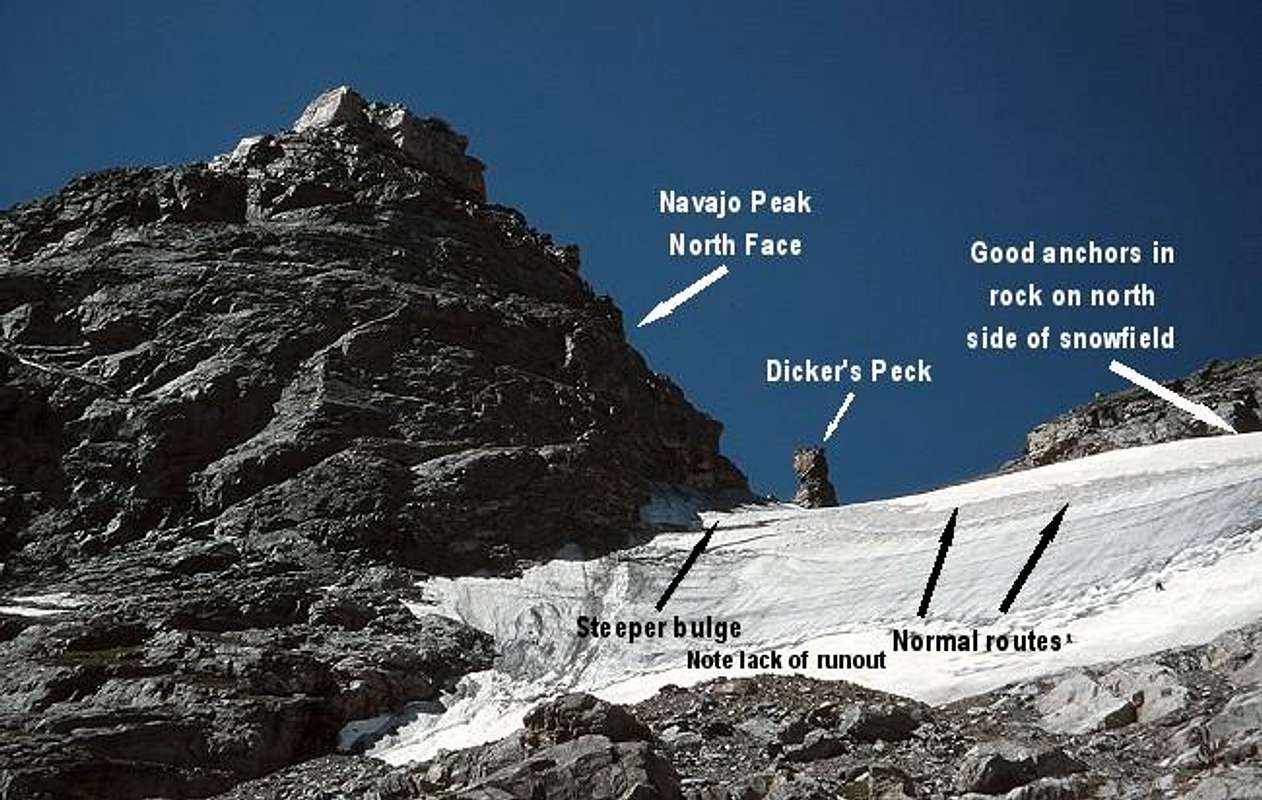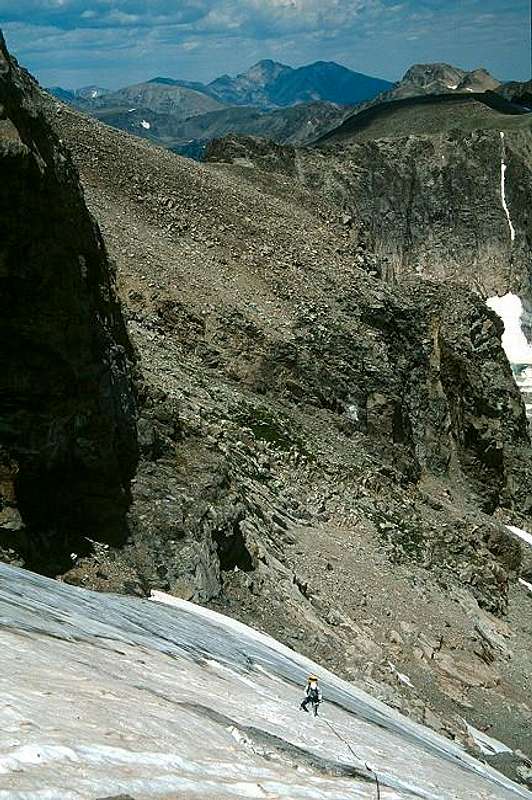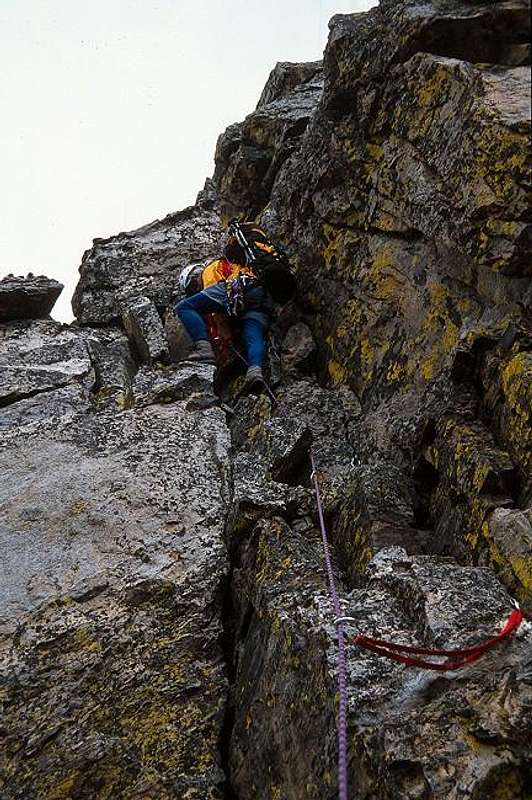|
|
Route |
|---|---|
|
|
40.05400°N / 105.646°W |
|
|
Basic Mountaineering |
|
|
A long day |
|
|
5.2 Rock, Moderate Snow / Ice |
|
|
Introduction

Navajo Peak and Snowfield, mid-July 1992. The effects of the drought evident by the black ice.
So, you are looking for an easy mixed mountaineering route in Colorado's Front Range? You want to be in the heart of spectacular and rugged mountains, while avoiding a long, grueling approach? The outing should last most of the day but you want to be home in time to bend elbows at your favorite watering hole? Look no further, this page is for you!
Navajo Peak's shape is unique in the Indian Peaks Wilderness. It's conical blocky summit is clearly visible when you are 40 miles east on Interstate 25, and is head-turner when you are hiking near it. The Navajo Snowfield and North Face combination is the best mountaineering route on the peak, and one of the best in the entire IPW. Guidebook author Gerry Roach says so, it must be true.
Approach
Follow the directions on the main page to the Long Lake trailhead. Hike past Long Lake and continue on to Lake Isabelle and beyond, towards the Isabelle Glacier, using the Airplane Gully approach. The slope steepens past the unnamed lake above Lake Isabelle, and if it is snow covered it will be time to get out your ice axe. Above this slope turn left (south), and face Airplane Gully. Navajo Snowfield will be prominent on your right, just north of the peak. The hike from the trailhead to the base of the climb is nearly 4 miles with 2,000 feet of elevation gain The entire walk is one superb Front Range beauty. Other climbs in this cirque include Queens Way and Apache Couloir. The basin is an alpine playground.
Route Description
 |  |
| Climbing on the upper section of Navajo Snowfield. | The North Face crux crack, below the summit block. |
This route consists of two distinct sections. First the snowfield, rising 800 vertical feet to the saddle between Navajo and Apache, where sits the whimsically named spire, Dicker's Peck. From the saddle you climb another 400 feet up the granite of the north face to the peak's summit block.
Like many of the Front Range's wide snowfields (as opposed to narrow couloirs) the angle varies depending upon the line you chose. In this case there is a steep bulge on the south (left) side, which is probably 55 degrees. The center and right sides maintain a steady 45 degree slope. The steep south side tends to ice up earlier than the more gentle north, and the base of the entire snowfield ends abruptly in a jumble of boulders and talus.
I climbed this in the drought year of 2002 and by mid-July an ominous band of black ice already stretched across the entire slope, as you can see in the photos. It was ominous because, not expecting it, my friend and I were not carrying any ice gear. Besides, that stuff is heavy and we are not ice climbers. Our 3 or 4 snow pickets were inadequate for the job. After checking the ice conditions we decided to climb along the northern edge, where we could use a running belay and place protection in the rock wall flanking the snow. Climbing several hundred feet in this fashion led us to a belay stance where a short left traverse got us over the ice and onto firm snow above. From there we continued the running belay, now using our pickets for anchors.
At the top of the snowfield make your way south past Dicker's Peck. Climbing this tower would be nice extra credit, but it is 5.7-ish, and I have nothing to report, other than it is impressive looking.
The north face of Navajo towers above you. The route we chose traversed left, then turned sharply right climbing to the crux crack directly below the north west corner of the summit block. This lower section was solid class 4, where we enjoyed moving quickly and unroped. We roped up again for the short 5.2 crux crack, which is only 15-20 feet high. This puts you on a class 3 ledge that swings around the west side of the summit block, eventually joining up with the final part of the Airplane Gully route on the south side of the peak. The summit is a spectacular perch, with the rugged Continental Divide stretching forever to the north and south. The forbidden Boulder watershed and Arikaree Peak are tantalizingly close.
Note that another ascent option would be to take Class 4 West Chimney, rather than the North Face. Lots to do on this excellent mountain!
It is about 4 miles and 3,000 feet of elevation gain from the trailhead.
The normal descent route would be down Airplane Gully, its uninviting loose rock not withstanding. I have seen people glissade down Navajo Snowfield. If the snow is soft that might be OK, but failure to self arrest in firm snow or ice would be a bad situation. My choice would be to avoid that, but use your judgment.
Essential Gear
Depending on snow or ice conditions, and the line you choose to take, on the snowfield you will want at least a mountaineering axe and crampons, perhaps a rope and some snow pickets, and possibly even a few ice screws and a second tool. Generally you will need more gear as the season progresses from June into September. A very minimal rack, a few of mid-sized cams and stoppers, will suffice for the short rock crack. In fact having done that once, if the snow was OK I'd be tempted to leave the rope behind all together and just get over the difficult section carefully and quickly. Don't forget your helmet. As we were descending Airplane Gully we could see the impact marks where fresh rockfall had crossed our path later in the day.
That said, the most dangerous rockfall of the day was encountered driving up the canyon, where a hefty boulder, the size of a small elephant, presented its own objective hazard in the middle of a curve in the road. That was removed by the time we returned after the climb, and did not obstruct our drive to a Fort Collins brewpub.



